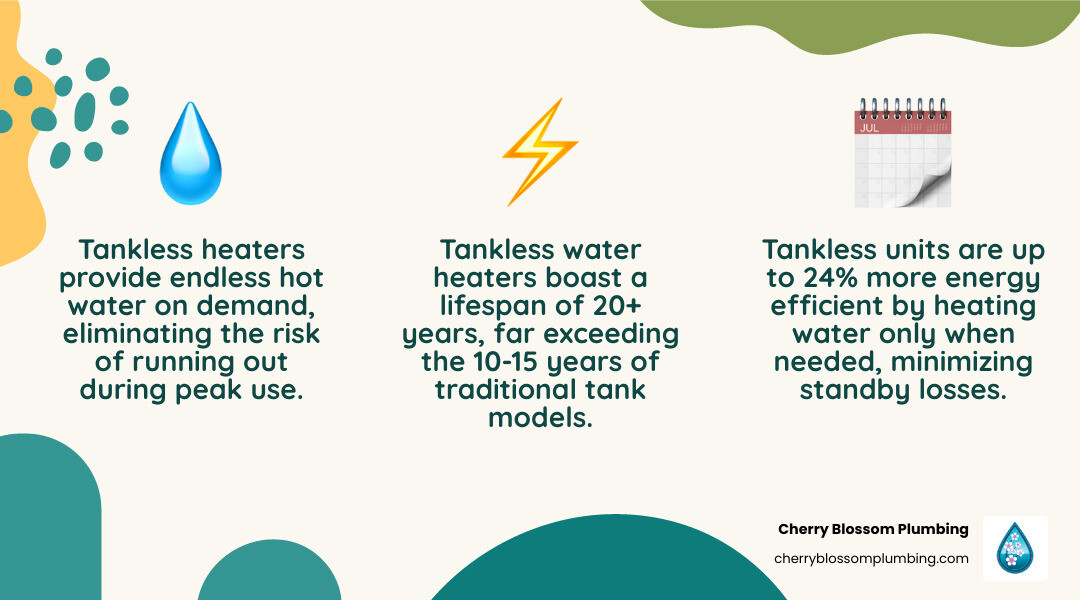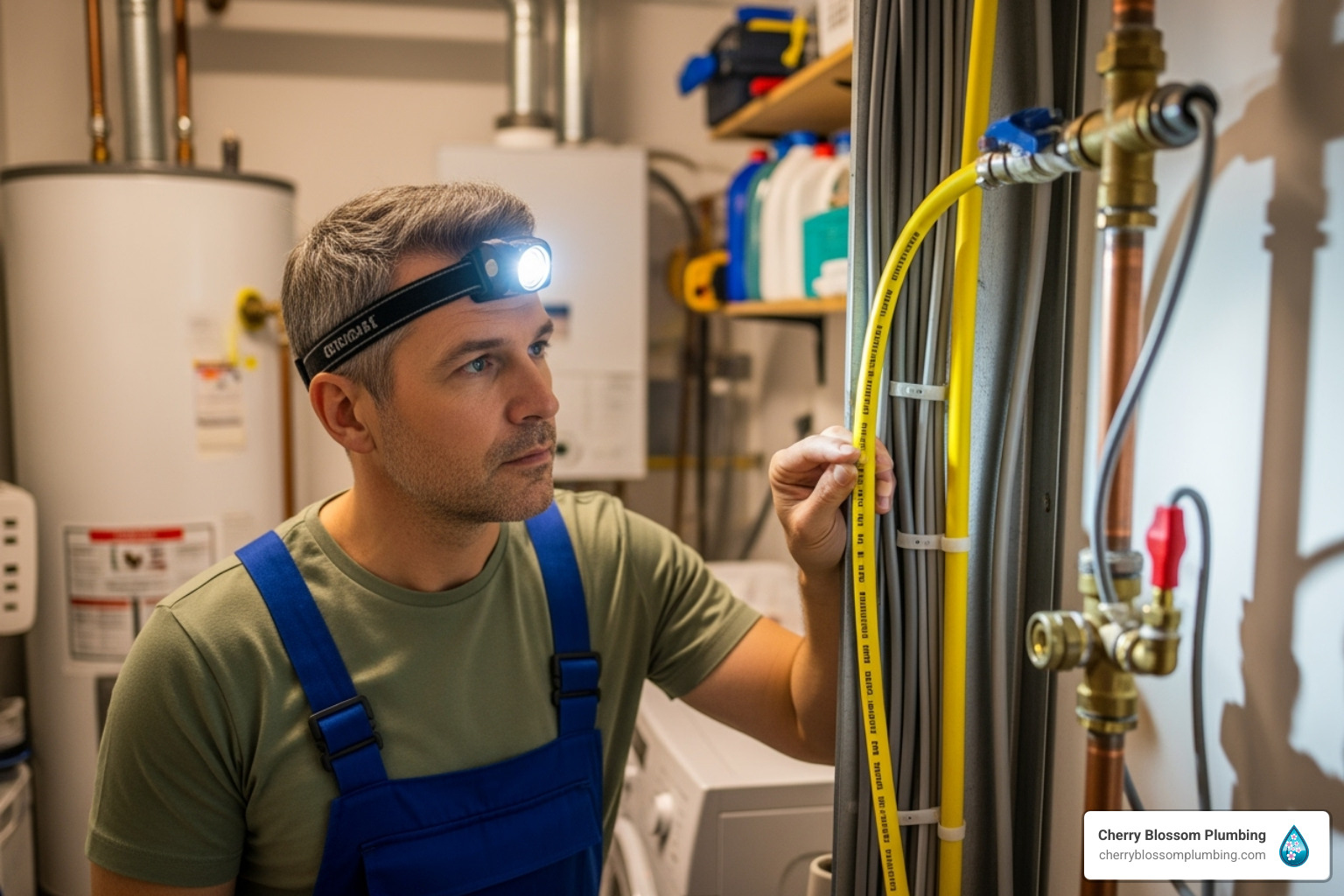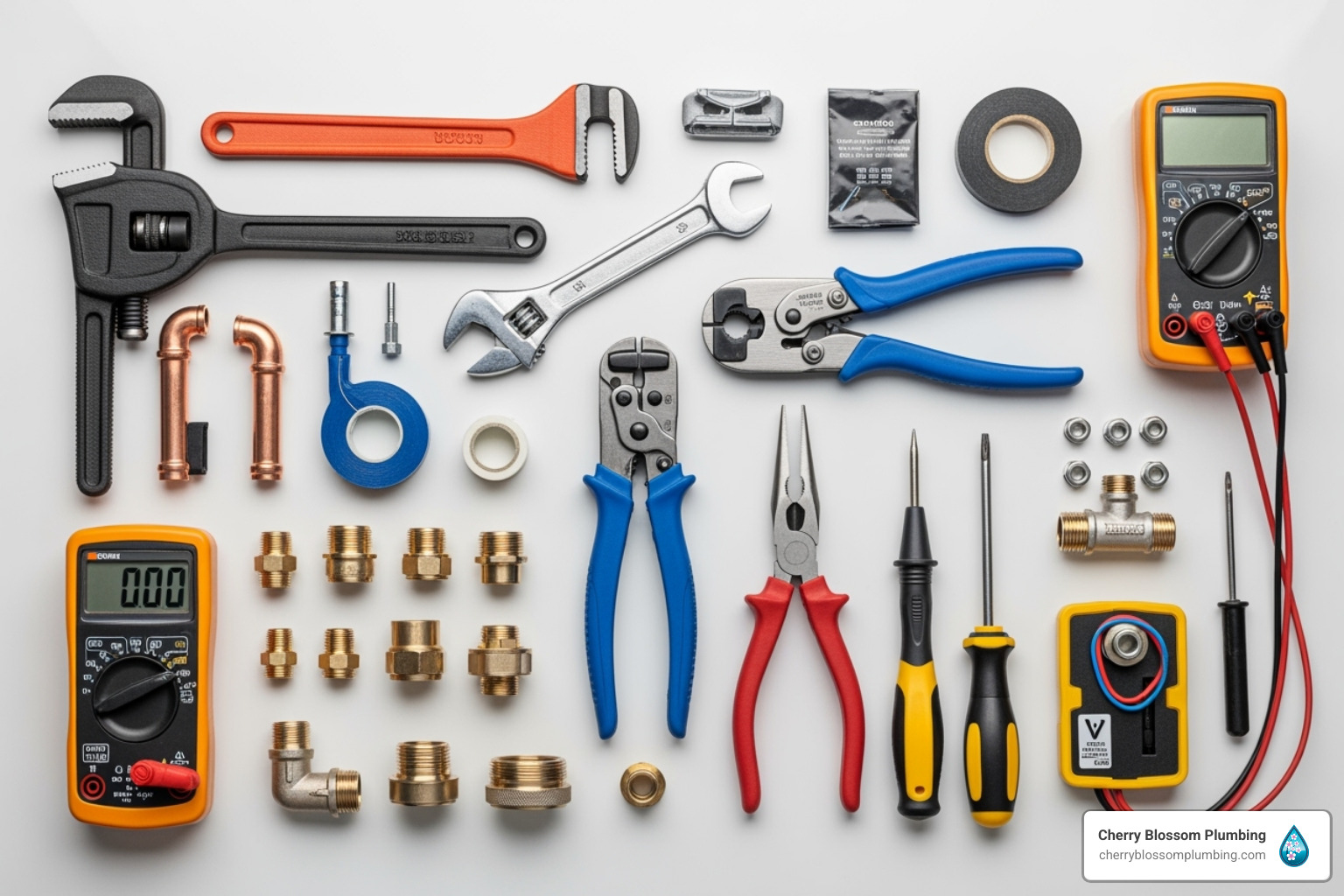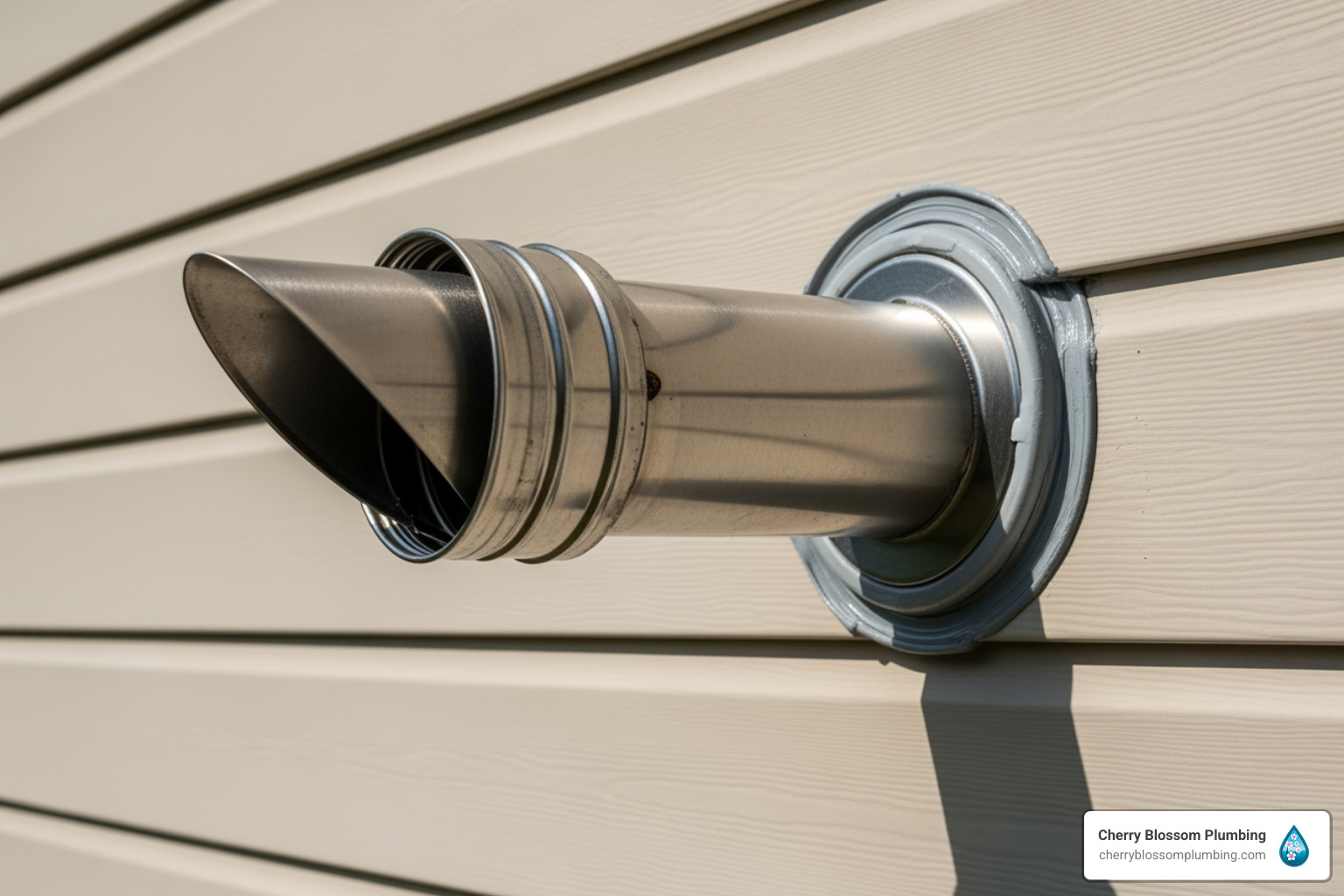Why Tankless Water Heater Installation Is Worth the Investment
Tankless water heater installation has become increasingly popular among homeowners seeking endless hot water and energy savings. Unlike traditional tank heaters that constantly heat and reheat water, tankless units heat water on-demand as it flows through the system, delivering hot water instantly when you need it.
Key benefits of tankless water heater installation:
- 24% more energy efficient than traditional tank water heaters
- Endless hot water supply – never run out during back-to-back showers
- 20+ year lifespan compared to 10-15 years for tank heaters
- Space-saving design – wall-mounted units free up floor space
- On-demand heating eliminates standby energy losses
However, tankless water heater installation is far more complex than replacing a traditional tank. The process involves upgrading gas lines, installing new venting systems, and potentially upgrading electrical panels. Gas units often require larger gas lines due to their higher BTU demand (90k-130k BTU/H versus 30k BTU/H for tanks), while electric units may need multiple 40-amp breakers.
Professional installation is crucial because improper installation can void warranties and create serious safety risks, including fire hazards and carbon monoxide exposure. As one industry expert notes: “Installing a tankless gas water heater is a difficult and sometimes dangerous process that requires a licensed professional.”
The installation process typically involves removing your old heater, upgrading infrastructure, mounting the new unit, connecting water and gas/electrical lines, and installing proper venting. While the upfront investment is higher, the long-term benefits make it worthwhile for most homeowners.
Before You Begin: Planning Your Upgrade
Think of planning your tankless water heater installation like planning a kitchen renovation – you wouldn’t just walk into a store and buy the first unit you see, right? The magic happens in the planning phase, where we match the perfect system to your home’s unique needs and your family’s hot water habits.
A thorough pre-installation assessment sets the foundation for everything that follows. We’re not just looking at what you have now – we’re envisioning how your new tankless system will work seamlessly with your home’s infrastructure for years to come.
Getting the Size Just Right
Here’s where many homeowners get tripped up – sizing a tankless water heater isn’t about picking small, medium, or large. It’s about understanding exactly how much hot water your family uses at peak times.
Flow rate (GPM) tells us how many gallons per minute your unit needs to deliver. Picture this: it’s Monday morning, and two teenagers are showering while you’re running the dishwasher. Each shower uses about 2.5 GPM, and that dishwasher adds another 1.5 GPM. That’s 6.5 GPM right there – and we haven’t even counted the washing machine yet!
BTU input is where gas units really shine. While your old tank water heater might have chugged along with 30,000 BTUs per hour, a tankless unit needs to bring its A-game with anywhere from 90,000 to 130,000 BTUs per hour. It’s like the difference between a steady jog and a sprint – when you turn on that hot water tap, your tankless unit fires up full throttle to heat water instantly.
Climate considerations matter more than you might think, especially here in Northern Virginia. When your groundwater comes in at a chilly 50°F in winter, your tankless unit has to work harder to bring it up to that perfect shower temperature. The colder your starting point, the more heating power you’ll need.
Choosing Your Fuel: Gas vs. Electric
The fuel type decision often comes down to what your home can handle and what makes sense for your family’s hot water needs.
Gas tankless heaters are the workhorses of the tankless world. They heat water quickly and can handle whole-home demands without breaking a sweat. But they do need proper gas line sizing and venting – no shortcuts allowed.
Electric tankless heaters offer incredible efficiency and can be tucked into tight spaces for point-of-use applications. Want instant hot water at your kitchen sink? An electric unit might be perfect. For whole-home use, though, they often require significant electrical upgrades.
For deeper insights into making this choice, our guide on Choosing the Best Tankless Water Heater walks you through all the considerations.
Finding the Perfect Spot
Installation location isn’t just about convenience – it’s about creating the most efficient system possible. We’re looking at proximity to your main water lines, access to gas or electrical connections, and those all-important venting requirements for gas units.
Code compliance keeps everyone safe and ensures your installation passes inspection. Local building codes aren’t suggestions – they’re the rules that protect your family and your investment.
Essential considerations for your tankless water heater installation
Before we even think about installing your new tankless unit, we need to take a good, hard look at what you’re working with. Your existing infrastructure tells the whole story of what your installation will involve.
Gas line size is often the biggest surprise for homeowners. That 1/2-inch gas line that perfectly served your old tank water heater? It’s probably going to need an upgrade – sometimes jumping all the way to a 1-inch line. Think of it like trying to drink a milkshake through a coffee stirrer – your tankless unit needs a bigger “straw” to get the fuel it needs.
Electrical panel capacity becomes the star of the show for electric units. These systems are hungry for power, often requiring multiple 40-amp breakers. If your electrical panel is already maxed out, we might be looking at a panel upgrade before we can even think about installing your tankless unit.
Venting options for gas units follow strict rules. Gas tankless water heaters must be direct-vented to the outside – no exceptions. Their exhaust gases are too cool for traditional chimneys, so we need to create a dedicated path to the outdoors with the right materials and proper sealing.
Water hardness might not seem like an installation issue, but it absolutely affects your long-term satisfaction. Hard water loves to leave mineral deposits inside tankless units, which can reduce efficiency and shorten lifespan. It’s worth discussing water treatment options now rather than dealing with scaling problems later.
Our comprehensive Tankless Water Heater Installation Guide dives even deeper into these crucial planning steps, helping you understand exactly what your installation will involve.
The Professional Tankless Water Heater Installation Process Step-by-Step
When it comes to tankless water heater installation, we’re not just swapping out an old appliance – we’re orchestrating a complete change of your home’s hot water system. Think of it like performing surgery on your house’s plumbing: every cut, connection, and component matters.
Safety always comes first in our book. Before we even think about touching a wrench, we shut down all the utilities – water, gas, and electricity. It’s like putting your home’s systems to sleep while we work our magic. Our technicians arrive with a complete arsenal of professional tools, from specialized pipe cutters to gas pressure testing equipment, because the right tool for the job makes all the difference between a good installation and a great one.
Step 1: Removing the Old Water Heater and Preparing the Space
Saying goodbye to your old water heater is a bit like moving out of an apartment – there’s more involved than you might expect, and you want to leave everything clean for the next occupant.
We start by draining the tank using a heat-rated hose connected to the drain valve. Why heat-rated? Because that water can be scorching hot, and a regular garden hose would melt faster than ice cream on a summer day. The water gets safely directed to a floor drain or utility sink.
Next comes disconnecting the water lines – both hot and cold supply lines need to be carefully removed from the old unit. This usually means loosening pipe fittings or making precise cuts in copper pipes.
The gas or electrical disconnection is where things get serious. For gas units, we carefully disconnect the gas supply line with extreme caution. For electric units, we safely disconnect all electrical wiring from the circuit breaker. These aren’t DIY moments – one wrong move could create dangerous situations.
Proper disposal of your old tank is something we handle completely. These units are heavy, bulky, and need to be recycled according to local regulations. Consider it our parting gift to your old faithful water heater.
Finally, we clear the installation area completely. This gives our technicians room to work safely and efficiently, with easy access to all the utility connections they’ll need for your new system.
Step 2: Mounting the Unit and Making Connections
Now for the exciting part – installing your sleek new tankless unit! This is where the magic happens, and your wall-mounted space-saver comes to life.
Secure wall mounting is crucial since your new unit will be living on the wall for the next 20+ years. We often build a sturdy mounting box from 2×4 lumber and plywood to provide proper clearance from the wall. This ensures adequate space for venting and future maintenance access.
Water line plumbing involves connecting new hot and cold water lines to your tankless unit. We’re experts at soldering pipes – creating those perfect, leak-proof joints that will serve you faithfully for decades. The pressure relief valve gets installed as a critical safety feature, acting like a safety net that releases excess pressure if water overheats.
For gas units, gas line installation is often the most complex part of the entire tankless water heater installation. Remember how we talked about needing larger gas lines? This is where that upgrade happens. We install a new gas shut-off valve, a tee connection, and a sediment trap that catches any debris before it reaches your unit. After making all connections, we perform rigorous pressure testing to ensure absolutely no gas leaks exist.
Even gas tankless units need electrical circuit requirements – they need 120-volt power for their control boards and igniters. Electric units are a different beast entirely, typically requiring dedicated 240-volt circuits with heavy-duty wiring. We always follow manufacturer specifications to the letter, because your safety and the unit’s performance depend on it.
For more technical details about these connections, check out our comprehensive guide on Installing a Tankless Water Heater.
Step 3: Venting and Final Checks
The home stretch of your tankless water heater installation focuses on safe venting and making sure everything works perfectly before we shake hands and call it a day.
Direct-vent systems are mandatory for gas tankless units. Unlike traditional water heaters that can use existing chimneys, these units need their own dedicated path to the outside. We carefully drill through your exterior wall or roof to create this pathway.
The choice between condensing vs. non-condensing vents depends on your specific unit. Non-condensing models typically use stainless steel vent pipes, while high-efficiency condensing units produce acidic condensate and require special PVC or CPVC venting materials. We use the right materials for your specific unit.
Sealing connections might sound boring, but it’s absolutely critical. Every plumbing joint, gas connection, and electrical connection gets our meticulous attention. Think of it as the difference between a house that’s weatherproof and one that leaks.
Leak testing is our quality control checkpoint. We turn on the water supply and inspect every joint visually for water leaks. For gas connections, we use pressure test gauges and leak detection solutions – because when it comes to gas safety, “pretty sure” isn’t good enough.
Commissioning the unit is the grand finale. We purge air from the water pipes, plug in your new water heater, and carefully turn on the gas supply. Following the manufacturer’s start-up procedures exactly, we ensure your unit fires up correctly and operates as designed. We even insulate the hot water pipe leaving the unit to maximize your energy efficiency.
Once everything passes our rigorous testing, you’re ready to enjoy endless hot water! To keep your new system running at peak performance, learn how to Boost Tankless Water Heater Efficiency.
Key Factors Influencing Installation Cost and Complexity
Let’s be honest – tankless water heater installation isn’t exactly a weekend DIY project you tackle after watching a YouTube video. While the long-term benefits are absolutely worth it, understanding what drives the cost and complexity upfront helps you make informed decisions and avoid surprises.
The DIY Temptation: Why You Should Resist
We get it. The internet makes everything look easy, and saving money is always appealing. But here’s the thing – tankless water heater installation is one of those projects where cutting corners can literally put your family at risk.
Warranty voiding is just the beginning of your worries if you go the DIY route. Most manufacturers are crystal clear about this: improper installation by an unlicensed person voids your warranty completely. That means if something goes wrong with your shiny new unit, you’re buying another one out of pocket.
But the real concern is safety risks. We’re talking about gas lines that can cause explosions, carbon monoxide that can silently harm your family, and water damage that can destroy your home’s structure. As industry experts warn, “Improper installation can void the warranty and create risks of fire or asphyxiation.” That’s not a chance worth taking to save a few dollars.
The Benefits Tankless Water Heater Installation only come to life when the job is done safely and correctly by professionals who know what they’re doing.
Infrastructure Upgrades: The Real Cost Drivers
Here’s where things get interesting – and potentially expensive. Your home’s existing infrastructure often needs significant upgrades to support a tankless system. Think of it like buying a sports car but finding your garage needs to be completely rebuilt to fit it.
Permit requirements are non-negotiable in most areas, including here in Arlington and Falls Church. These aren’t bureaucratic problems designed to annoy you – they ensure your installation meets safety codes and gets properly inspected. The good news? We handle all the permitting paperwork for you.
The biggest surprise for many homeowners comes from finding their gas lines, electrical panels, or venting systems need major upgrades. A professional assessment upfront identifies these needs before work begins, preventing those dreaded mid-project findies that can double your timeline and budget.
Gas vs. Electric: Specifics of your tankless water heater installation
Your fuel choice dramatically impacts what your tankless water heater installation will involve. Each type brings its own unique challenges and requirements.
Gas Tankless Systems: Power Hungry Giants
Gas line upgrades are almost inevitable with whole-home gas tankless units. Remember those BTU numbers we discussed earlier? Your existing half-inch gas line that happily fed your old tank heater simply can’t handle the 90,000 to 130,000 BTU demand of a tankless unit. We often need to upgrade to three-quarter-inch or even one-inch lines.
This higher BTU demand affects your entire home’s gas system. We need to verify your gas meter and main line can handle the increased load, especially when your furnace, stove, and dryer might also be running. It’s like making sure your home’s electrical system can handle adding a hot tub – everything needs to work together.
Direct-venting requirements add another layer of complexity. These units produce combustion gases that must go directly outside through specialized venting materials. No shortcuts, no existing chimneys – just proper, code-compliant venting that keeps your family safe.
Electric Tankless Systems: The Electrical Marathon
Electric units present their own challenges, starting with dedicated electrical circuits. These power-hungry units typically need multiple 240-volt circuits, each with its own high-amperage breaker. We’re talking about serious electrical demand here.
Electrical panel upgrades often become necessary when your existing panel can’t handle the additional load or doesn’t have available slots for new breakers. This can transform a straightforward water heater installation into a major electrical project.
Point-of-use models offer a middle ground for electric systems. These smaller units serve individual fixtures and require less electrical infrastructure, making them perfect for specific applications like a master bathroom or kitchen sink.
Here’s how gas and electric installations typically compare:
| Consideration | Gas Units | Electric Units |
|---|---|---|
| Power Demand | Very High BTU (90K-199K) | High Electrical (240V, multiple 40A breakers) |
| Infrastructure Upgrades | Gas line sizing, direct venting | Electrical panel, dedicated circuits |
| Complexity Level | High (gas, venting, plumbing) | Moderate to High (electrical, plumbing) |
| Space Requirements | Wall-mounted, venting clearances | Compact, often point-of-use options |
Why Professional Installation is Crucial
Given everything we’ve discussed, professional tankless water heater installation isn’t just recommended – it’s essential for your family’s safety and your investment’s protection.
Here’s what separates true professionals from the rest, and what we bring to every installation:
Licensed and insured professionals demonstrate proven competence and protect you from liability. Our licensing shows we’ve met industry standards, while our insurance covers you if anything unexpected happens during installation.
Tankless-specific experience matters tremendously. Installing traditional water heaters and tankless units are completely different skill sets. We’ve handled countless tankless installations across Northern Virginia and understand the unique challenges each brand and model presents.
Code knowledge keeps evolving, and it varies by location. We stay current with all local plumbing, gas, and electrical codes in Arlington, Falls Church, and surrounding areas. This ensures your installation passes inspection the first time.
Safety protocols are non-negotiable when working with gas lines, high-voltage electricity, and pressurized water systems. The risks of fire and carbon monoxide poisoning from improper installation are real and potentially fatal. We follow strict procedures to eliminate these dangers completely.
Your family’s safety and your investment’s protection are too important to leave to chance. Professional installation ensures you get all those amazing tankless benefits without any of the risks.
Frequently Asked Questions about Tankless Heater Installation
We get it – making the switch to a tankless system is a big decision, and you probably have a million questions swirling around in your head. Don’t worry, you’re not alone! These are the questions we hear most often from homeowners considering a tankless water heater installation, and we’re here to give you the straight answers.
How long does a tankless water heater last compared to a tank model?
Here’s some great news that’ll make your wallet happy: a tankless water heater can last up to 20 years, which is significantly longer than the 10-15 year lifespan of a traditional tank heater. That means you’re looking at nearly double the lifespan!
This extended durability makes the initial investment much more worthwhile when you think about it long-term. You’ll deal with fewer replacements, less hassle, and more years of reliable hot water. The secret? Tankless units have fewer points of failure compared to their tank counterparts.
Most importantly, they don’t have that big storage tank that’s prone to leaks, rust, and eventual failure – which is often what kills traditional water heaters. It’s like comparing a smartphone to an old flip phone; the simpler, more efficient design just lasts longer.
Do I need a permit for a tankless water heater installation?
Yes, and here’s why that’s actually a good thing for you. In most areas, including Arlington, VA, installing a new water heater requires a permit because the work involves plumbing, gas, and electrical systems. Think of it as a safety net that protects you and your family.
Getting a permit ensures your installation is inspected for safety and code compliance. It’s not red tape for the sake of red tape – it’s documentation that the work was done right and meets all local safety standards. This becomes incredibly valuable if you ever sell your home or need to file an insurance claim.
The best part? We handle all the permitting paperwork for your tankless water heater installation. You don’t have to steer the bureaucratic maze or worry about missing something important. We take care of the entire process from start to finish, ensuring everything is compliant and properly documented.
Can one tankless water heater provide enough hot water for my whole house?
Generally, yes – but there’s a bit more to it than that simple answer. A properly sized whole-home tankless unit can absolutely meet the demands of a typical family. The key phrase there is “properly sized.”
Sizing depends on two main factors: your peak hot water usage (measured in gallons per minute or GPM) and the temperature of your incoming groundwater. This is where our professional assessment really shines – we calculate exactly what you need based on your specific situation.
Here’s the thing about “endless” hot water: while tankless units won’t run out like a tank would, they are limited by their flow rate capacity. If you have a large family that loves long showers, or you frequently run multiple high-demand fixtures at once (think two showers plus the washing machine and dishwasher), you might experience what we call the “cold water sandwich” effect or reduced water pressure.
For households with very high simultaneous demand, we might recommend a larger unit or even a combination approach with multiple units. During our consultation, we’ll look at your family’s hot water habits, count your fixtures, and recommend the perfect solution that ensures everyone gets plenty of hot water without any unpleasant surprises.
Your Partner for a Perfect Installation
Making the leap to a tankless water heater installation is one of the smartest investments you can make for your home’s efficiency, comfort, and long-term value. We know it might seem overwhelming at first – there’s a lot of technical details, infrastructure considerations, and safety requirements to steer. But here’s the thing: you don’t have to figure it all out on your own.
Understanding the installation process helps you make informed decisions, but executing it safely and correctly? That’s where our expertise really shines. At Cherry Blossom Plumbing, we’ve guided countless Arlington and Falls Church families through this upgrade, and we’ve seen how transformative it can be. There’s nothing quite like that moment when you realize you’ll never run out of hot water again – even during those chaotic morning routines when everyone needs to shower at once!
The difference between a good installation and a great one comes down to attention to detail, experience with the unique challenges of tankless systems, and a commitment to safety that never wavers. We don’t just install your unit and walk away. We take the time to optimize your system for peak performance, ensure every connection meets or exceeds code requirements, and make sure you understand how to get the most out of your investment for years to come.
Our “WOW factor” guarantee isn’t just a catchy phrase – it’s our promise that your tankless water heater installation will exceed your expectations from start to finish. We handle everything from permits and infrastructure upgrades to the final commissioning and testing. You’ll have peace of mind knowing your system is installed by licensed professionals who understand the intricacies of gas lines, electrical requirements, and proper venting.
Ready to say goodbye to cold showers and hello to endless hot water? Your family deserves the comfort and efficiency that only a professionally installed tankless water heater can provide. Contact us today for your tankless water heater installation in Arlington, VA, and let’s get started on changing your home’s hot water experience.




